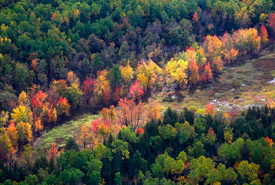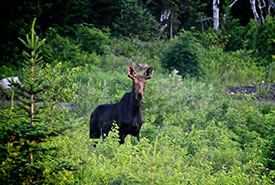Connectivity: Passages for species to migrate

Vicente-Vallée de l'Outaouais, QC (Photo by Mike Dembeck)
What is connectivity? Connectivity is a fundamental principle in nature conservation. Protecting and restoring connectivity is critical in landscapes that have been fragmented by roads, cities and farms. We can conserve connectivity for wildlife by protecting corridors that allow them to move between different habitats.
Wildlife corridors are land or water passages that connect areas together. These corridors play a leading role in connectivity. Like a path through a forest, corridors allow animals to move and plants to disperse to habitats where they can reproduce, feed and find shelter — in short, meet their vital needs. Connectivity is essential for wildlife to remain healthy.
By protecting wildlife corridors, the Nature Conservancy of Canada (NCC) and our partners are ensuring that species can migrate from one habitat to another.
Benefits of wildlife corridors
- Seasonal migration of animals;
- Range shifts due to climate change; and
- Prevents genetic isolation of wildlife populations.
Adaptation of species to climate change
One of the new threats that wildlife faces is climate change.
Because of climate change, it is estimated that wildlife species in Quebec will migrate northwards an average of 45 kilometres per decade. This means that major corridors across North America provide an essential means for them to adapt to global climate change by shifting their ranges.
Species isolation

Moose on Mount Hereford, QC (Photo by MRC de Coaticook)
Human actions can reduce connectivity. Roads, farms and cities can divide territories and as a result habitats, isolating plants and animals.
For example, a highway or industrial site can prevent trees from spreading if their seeds cannot disperse to new habitats. When species are isolated, there is a higher chance they will become locally extinct.
Large mammals, including bear, moose and lynx, need a large area to sustain themselves, reproduce and take refuge — in other words, to survive. Moose can have a home range of over 60 square kilometres. If they can’t move through their home range because of roads and other barriers, they can disappear.
Wildlife corridors play a crucial role in countering isolation, as they reduce the risk of animals and plants becoming confined and extinct.
Raising public awareness
Wildlife corridors supports a healthy natural environment. And healthy ecosystems support people's well-being and economies. Nature also provides people with valuable services, such as recreation (fishing, hunting, birdwatching, navigation, etc.) and other, more vital, services.
Wetlands are true natural buffers. By retaining water, they provide invaluable assistance against floods and torrential rain. As for the psychological and physical benefits of a walk in the open air, they speak for themselves.
The Nature Conservancy of Canada (NCC) launched the Quebec Ecological Corridors Initiative (QECI) in 2017 to accelerate the conservation of natural areas connected by ecological corridors. The initiative is coordinated by NCC and led by a group of 10 organizations. The group offers a collective approach to land use planning and advises provincial and municipal governments, woodlot owners, farmers and other key stakeholders. The group also carries out mobilization, capacity building, recognition and support activities throughout southern Quebec.
QECI is supported by over 100 experts and stakeholders and receives most of its funding from the following organizations: the Government of Quebec (under the Action-Climat Québec program which meets the objectives of the 2030 Plan for a Green Economy), the Government of Canada’s Ministry of Environment and Climate Change, the Woodcock Foundation and Fondation de la faune du Québec.
View the interactive map of connectivity projects in Quebec!
Are you a municipality thinking about collaborating with conservation organizations? Discover our information sheet for municipalities on the subject (french), prepared by the Réseau de milieux naturels protégés (RMN) in partnership with NCC!
Together, we can protect these corridors, which are vital to ecosystems. By ensuring the conservation of natural environments, Quebec will remain a great place to live and thrive.





